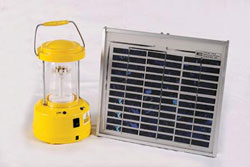Solar lanterns are doing more than just bringing light to the poor in India. They also have improved the standard of living for those who formerly relied on kerosene lamps, a recent study asserts.
Govindasamy Agoramoorthy, a professor at Tajen University, and Minna J. Hsu, from National Sun Yat-sen University, both in Taiwan, studied the effects of solar lanterns in 25 villages in the Dahod District of Gujarat State, India. They focused on people helped through the NM Sadguru Water and Development Foundation, a local organization that sells lanterns on an installment basis, and they looked at changes in quality of life, energy use and household savings.

Solar-powered lanterns are improving the lives of people in impoverished areas of India. Courtesy of Vimal Electronics.
Many nonprofit groups supply solar lanterns to rural households in India, but Agoramoorthy said that the foundation’s philosophy is not to offer things for free but, instead, for social workers to help the poor upgrade their living standards. Although 70 percent of the villages in the study were connected to the power grid, they did not receive power in the early morning or evening. Women in rural households were interviewed both before and after purchasing the lanterns, and the study found that, with the lanterns, women could perform routine household chores at any time, students’ study hours increased, and school performance improved.
The lanterns save about 100 liters of kerosene per year and reduce electrical use. The study estimates a total savings of USD 91.55 in energy costs per year, a significant figure considering that annual income in that area ranges from $150 to $250.
Solar advantage
The sun shines an estimated 250 to 300 days a year in India, making it an attractive location for producing electricity. With the country’s growing economy, its energy use will double by 2020, according to the International Energy Agency’s World Energy Outlook 2007.
India’s renewable energy industry is estimated at $500 million, with a growth rate of 15 percent that includes solar, wind, hydro and other alternative energies. The government hopes to produce 10,000 MW of renewable energy by 2012, a goal that has the dual advantage of launching a leading solar energy market and of providing dependable and clean energy in both rural and urban areas.
Solar lantern use, which is growing at a rate of about 40 percent a year, is providing the people of India with a glimpse of all that is possible when they harness the sun.